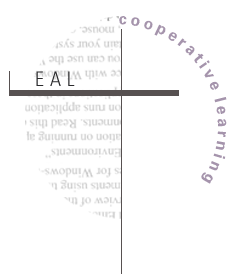
Five Levels of Cooperative Learning Activities for Adult Learners
Linda Thistlethwaite
Western Illinois University
Cooperative learning is a natural for the adult education classroom (Thistlethwaite, 1994). After all, group problem-solving is how adults handle most real-world problems. Cooperative learning also mirrors how adult education teachers themselves learn. Being able to work cooperatively contributes to an individual's success as a member of the workforce.
Definitions of Cooperative Learning
Cooperative learning has both a general and a specific definition.
Generally, any venture where people are sharing the learning experience
in some manner is a cooperative venture.
Johnson and Johnson (1991) have more specifically defined cooperative
learning to include four necessary components: face-to-face interaction,
positive goal interdependence, individual accountability, and
demonstration of interpersonal and small group skills.
The term collaborative learning should also be considered. Generally, collaboration is less-structured than cooperative learning. Although you may find many of the same components, they are less formally addressed. Learners often enter into collaborations of their own free will. Cooperative learning, on the other hand, is usually structured by someone other than the learners. Additionally, sometimes in a cooperative venture each member needs to "give up" something for the good of the group, to compromise. On the other hand, in collaborations each person gains without compromising. No definitive differentiation between these two terms exists although individuals certainly have different connotations for them.
Adult Education - Special Considerations
When using cooperative/collaborative learning in the adult education
setting, special concerns must be addressed. Often times in a K-12 school
setting, an entire classroom will be divided into cooperative learning
groups with groups working on similar tasks. In adult education
classrooms, learners frequently are NOT working on the same general task;
therefore, there is no necessity for everyone being in a cooperative
learning group at the same time. Only a part of the class may be working
in a small group format.
Since grades are not typically assigned in adult education classes and since motivation to learn for the sake of knowing the information may be higher than it is in the typical K-12 classroom, the concept of accountability needs to be modified. Students are typically not working together in order to achieve some group grade. Individual accountability might be thought of more in terms of progress toward individual goals than in terms of a grade earned.
The social skills aspect of cooperative learning is very important in the adult education setting. A teacher cannot assume that just because the learners are adults that they will know how to work together. Group members need to learn how to listen to one another, how to share information, how to take turns, how to be considerate, how to use positive words of praise, how to disagree with an opinion or an issue rather than with the person expressing the idea, how to encourage all to participate, how to compromise to reach an agreement, how to evaluate the group's efforts, and how to evaluate one's personal contributions to the group. Both teachers and students must be aware that opinions about and reactions to group learning may be culture-specific.
Adult education teachers could benefit from understanding and discussing the implementation of cooperative learning according to Johnson and Johnson's definition of cooperative learning; however, it may be more useful to implement a more generalized version of small-group learning. Although cooperative learning IS more than just dividing students into groups, it need not be orchestrated in as detailed a manner as cooperative learning theorists suggest. Even though adult educators may want to modify the components for cooperative learning, they may find useful the variety of cooperative learning structures that Slavin (1990) discusses in his cooperative learning text, e.g., Think-Pair-Share, Co-Op, and Jigsaw.
Like with many educational concepts, it's a good idea to start small. Don't force people to participate in cooperative learning groups. Instead, set one up and have it open to others who may want to join as they observe the activity and find it appealing. Begin with pairs; work up to groups of three or four, perhaps simply by combining pairs.
Cooperative and Collaborative Activities
The activities described next illustrate how adult learners might
participate in a variety of learning experiences. At each level,
different degrees of cooperation are necessary. At the most basic level,
the learners don't even need to be in the same room at the same time! On
the other hand, at the highest level, group members have a specific and
on-going commitment to one another. Some of these activities are
appropriate for open-entrance/open-exit classes where independent work is
the norm while others necessitate a more typical classroom atmosphere
where attendance is more stable. However, no matter what characteristics
the learning enviroment has and no matter how wide the range of ability
levels of the students,
teachers can provide situations where adult learners can learn
effectively from one another.
Continue on by choosing the level you are interested in. The levels progress from very basic ( a ) to most advanced ( e ), or you can move on to the summary. Choose article to return to this page.
[ article . a . b . c . d . e . summary . references ]
acceptance date: 10/3/96